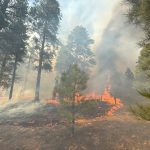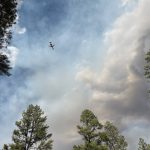
50 Years Ago | BIA’s ‘old range riders’ blamed for problems
If you asked Navajo Tribal Chairman Peter MacDonald in early 1972 who were the tribe’s worst enemies, he would reply “old range riders.”
He would use this phase for the next 10 years to refer to supervisors and department heads in the Bureau of Indian Affairs who had control of the tens of millions of dollars that were provided by Congress each year to run programs in the Navajo Reservation.
Whenever he said this in chapter meetings, he would be guaranteed to get a wide round of applause because of the poor relationship between the BIA and members of the tribe for almost a century. Name a problem on the reservation – alcoholism, high unemployment, lack of education and high crime rates – all were caused by BIA directors who had been in office 20 years or more and were just waiting for retirement.
In interviews MacDonald gave to Howard Graves, head of the Albuquerque Bureau of the Associated Press, throughout the early 1970s, he would constantly criticize the BIA for failure to resolve any of the problems that affected the Navajo people in 1972.
“They are old range riders from back in the 1930s who have worked their way up to the top echelons and have spent their entire careers turning their backs on the needs of the Navajo people,” he told Graves.
At the time, more than 90% of those in the higher echelons were non-Indian and to some this was becoming a race issue. And in some ways, it was characterized this way by national publication reporters who tried to explain to readers why the Indian people were still living in substandard conditions.
One article by a Washington Post reporter compared the way most Navajo families were living without water or electricity as the same as poor people in Third World countries.
In early 1972, Chet MacRorie, who was managing editor of the Navajo Times, embarked on a year-long crusade to pick up MacDonald’s message and try to bring national attention to the harsh conditions that many Navajo families lived under.
To do this, he published editorials and articles throughout the year taking the federal government to task for failing to improve the lifestyle of Navajo families living outside the main communities on the Navajo Reservation.
One article, for example, took readers to Gallup where each day hundreds of Navajo families lined up at a community well by the railroad tracks and filled up huge tanks with hundreds of gallons of water they would use over the next week.
Another article talked about the 30,000 or so Navajos who wanted jobs but could find none in their areas, forcing them to either move off the reservation or stay home and live on welfare.
He also pushed for newspapers in major cities to visit the reservation and do their own stories and once one did, it seemed to encourage other newspapers to send their own reporters to cover the story.
Unlike his predecessor, Raymond Nakai, who hated being interviewed, MacDonald welcomed all the publicity and made sure tribal leaders were available for interviews. He also had an active press office willing to step in and guide reporters to the people they needed to interview for their stories.
All of this resulted in MacDonald becoming probably the most recognized Native leader in America with the exception American Indian Movement leaders. AIM was also beginning to challenge the federal government by taking over federal facilities and holding demonstrations in bigger cities.
In the next year, MacDonald found himself fighting a movement by Republican members of Congress to cut back on federal funds to tribes and, in some cases, recommending that the federal government cut all funds to tribal governments.
Tribe takes over scholarship program
As part of his efforts to gain control over federal funds coming to the reservation, MacDonald had negotiated with the BIA for the tribe to take over federal programs. He announced this week that the tribe was given control over the federal program that provided scholarships to Navajo college students.
The federal government in 1972 was providing $1.6 million to fund the program which provided scholarships to just more than 1,000 college students.
The funds could only be used for undergraduates. Navajos attending graduate school had to look to the tribe for help.
College students who were accepted under the program would receive a minimum of $1,000, which covered tuition and books. They would have to find other resources – the tribe or their chapters – to help pay the costs of room and board.
More money was provided to Navajos who went to private schools but even there, students had to find other funding to meet all of their needs.
But this came with a major problem. Even with federal funds and another $600,000 or so from the tribe and chapters, there still was not enough funds to help all the students.
This would become a standard story over the years for Navajo Times reporters who would urge readers who wanted funds to file their request early and to make sure all of the paperwork was in before that year’s deadline.
And each year, the Times would report that hundreds of Navajos would be forced to postpone going to college because they failed to meet the deadlines or had all of their paperwork in by the deadline.








 Highway 264,
Highway 264, I-40, WB @ Winslow
I-40, WB @ Winslow